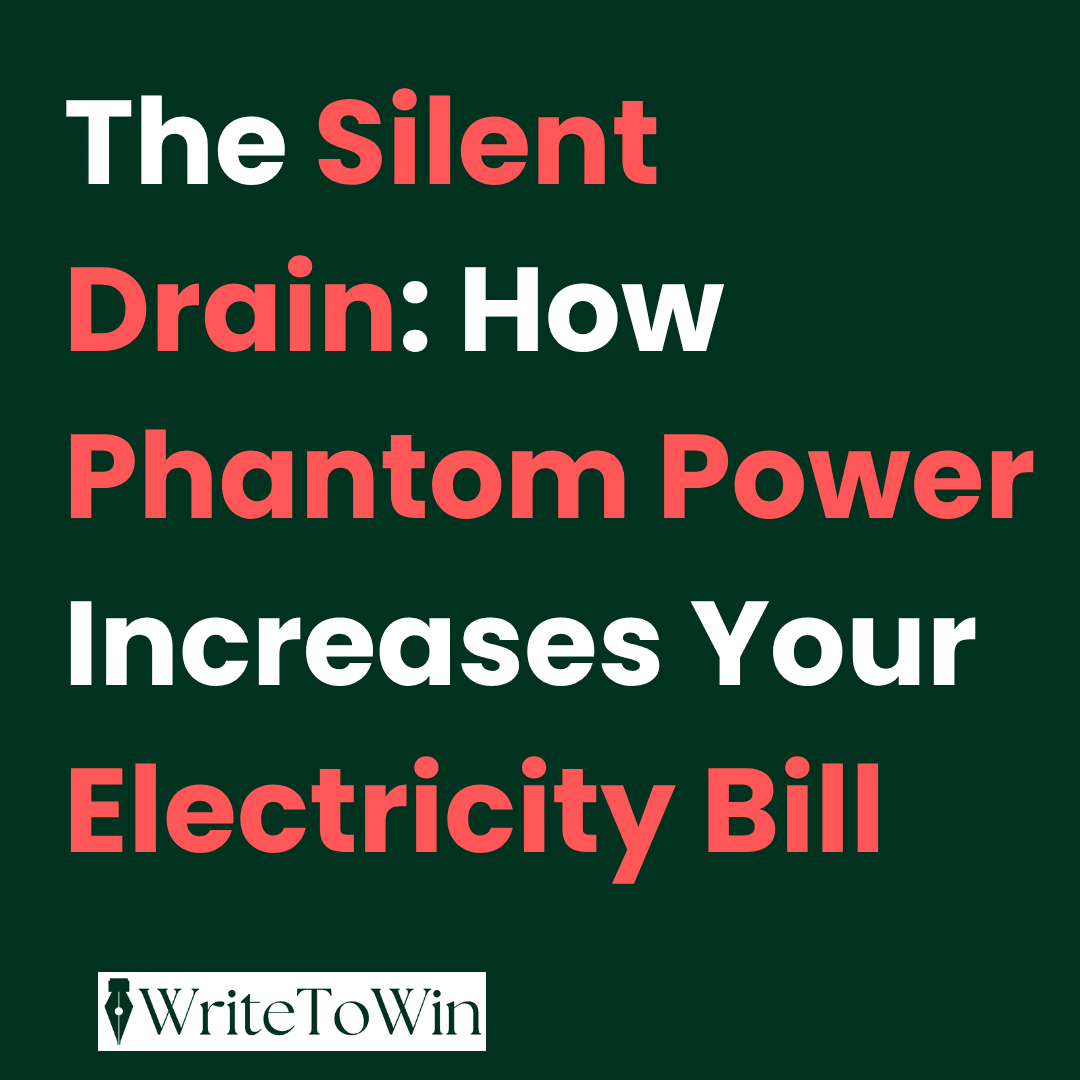Picture this: You’ve just received your monthly electricity bill, and your jaw drops. Despite your best efforts to switch off lights and unplug the iron, the numbers seem to climb higher each month. You scratch your head, wondering where all that power is going. After all, you’re not running an industrial operation from your living room or are you?
Here’s the plot twist that might surprise you: many of your household devices are secretly sipping electricity even when you think they’re completely off. Welcome to the world of “phantom power drain”, the invisible energy vampire that’s been quietly feeding off your wallet. Silent drain from standby devices quietly boosts your electricity bill without you noticing.
What Exactly Is Phantom Power?
Phantom power, also known as standby power or vampire power, is the electricity consumed by electronic devices when they’re plugged in but not actively in use. Think of it as your devices being in a light sleep rather than being fully awake or completely unconscious.
When you press the power button on your TV remote, your television doesn’t actually shut down completely. Instead, it goes into standby mode, keeping certain circuits active so it can instantly respond when you hit that power button again. It’s incredibly convenient, but this convenience comes with a hidden cost.
The phenomenon exists because modern devices need to maintain certain functions even when “off” like keeping internal clocks running, staying connected to Wi-Fi, or remaining ready to receive signals from remote controls. Your coffee maker needs to remember what time to start brewing, your smart TV wants to download updates overnight, and your gaming console is always listening for voice commands.

The Worst Offenders in Your Home
Not all devices are created equal when it comes to phantom power consumption. Some are energy-sipping angels, while others are absolute power gluttons. Here are the usual suspects:
Entertainment Systems: Your cable box is probably the biggest culprit, consuming almost as much power in standby mode as when you’re binge-watching your favourite series. Gaming consoles, especially when left in “instant-on” mode, can draw significant power even when you’re not playing.
Kitchen Appliances: That microwave with its perpetually glowing clock? It’s drawing power 24/7. Coffee makers with programmable timers, dishwashers with digital displays, and even some refrigerators with smart features can contribute to phantom drain.
Computer Equipment: Desktop computers, monitors, printers, and routers often remain partially active even when not in use. Your laptop charger continues to draw power even when your laptop isn’t connected to it.
Smart Home Devices: Voice assistants, smart speakers, and Wi-Fi-enabled appliances are always “listening” and staying connected, which requires continuous power.
Audio Equipment: Sound systems, speakers, and even some headphone charging stations maintain standby power to respond quickly when activated.
The irony? Some of the devices designed to make our lives more convenient are the ones costing us the most in phantom power consumption.
The Real Cost of Phantom Power: The Silent Drain on Your Bill
Here’s where things get interesting and a bit shocking. According to various studies, phantom power can account for 5-10% of your total electricity consumption. For an average household, this translates to anywhere from ₹500 to ₹6,000 annually, depending on the number and type of devices you own.
Let’s put this in perspective: imagine you’re unknowingly paying for an extra 40-watt light bulb that stays on 24 hours a day, 365 days a year. That’s essentially what a phantom power drain can amount to in many homes.
Multiply this across millions of households, and phantom power becomes a significant contributor to overall energy consumption. In fact, some estimates suggest that phantom loads account for nearly 1% of global CO2 emissions. That’s not just money out of your pocket, it’s an environmental impact that adds up on a massive scale.
The cost varies depending on your local electricity rates, but with rising energy prices, phantom power drain is becoming an increasingly expensive invisible expense. And here’s the kicker most people have no idea it’s happening.
Simple Solutions to Slash Phantom Power
The good news? Reducing phantom power drain doesn’t require a complete lifestyle overhaul or expensive equipment. Here are some practical strategies that can make a real difference:
Power Strips Are Your Best Friend: Invest in power strips with individual switches or smart power strips that automatically cut power to devices in standby mode. When you’re done using your entertainment center, flip one switch instead of hunting for multiple power buttons.
Unplug When Possible: For devices you don’t use daily like that guest bedroom TV or the bread maker you use once a month, simply unplugging them when not in use can eliminate phantom drain entirely.
Adjust Device Settings: Many modern devices have power management settings. Switch your gaming console from “instant-on” to “energy-saving” mode. Disable “quick start” features on TVs if you don’t mind waiting an extra few seconds for them to turn on.
Choose Energy-Efficient Devices: When shopping for new appliances, look for ENERGY STAR-certified products or check the standby power consumption in the specifications. Sometimes paying a bit more upfront can save significantly in the long run.
Smart Home Automation: Paradoxically, some smart home devices can help reduce phantom power by automatically managing other devices’ power consumption based on your usage patterns.
Regular Audits: Walk through your home and identify devices that have LED displays, digital clocks, or remote control receivers. These are prime candidates for phantom power consumption.
Issues like phantom power drain affect millions of people, yet they remain largely unknown to the general public. This is where the power of writing and sharing knowledge becomes crucial. When people understand problems that directly impact their daily lives and finances, they’re empowered to make informed decisions.
WriteToWin recognises this power of writing to create real-world impact. They’re encouraging writers to explore and share insights about practical issues that matter, whether it’s energy conservation, environmental awareness, Climate issues or social challenges that need more attention.
The beautiful thing about writing on topics like phantom power is that you’re not just sharing information, you’re potentially helping someone save money, reduce their environmental footprint, and make more conscious choices about their energy consumption. That’s the kind of writing that creates ripple effects.
If you’re passionate about issues that affect people’s daily lives, consider channelling that passion into writing. WriteToWin offers writers the opportunity to submit articles on meaningful topics while standing a chance to win rewards up to ₹1 lakh. But beyond the monetary incentive, there’s something deeply satisfying about knowing your words might inspire someone to take action that benefits both their wallet and the environment. For more details, please visit @WriteToWin.online
Making Every Watt Count
Understanding phantom power drain is just the beginning. The real impact comes when we take action both individually and collectively. Start small: unplug a few devices tonight before bed, or invest in a power strip for your entertainment center. Notice the difference in your next electricity bill.
But don’t stop there. Share what you learn with friends, family, and neighbours. Post about it on social media, discuss it at family gatherings, or write about it. The more people understand phantom power, the more collective impact we can have on reducing unnecessary energy consumption.
Remember, every watt saved not only keeps money in your pocket but also reduces demand on the power grid. In a world where energy resources are precious and environmental concerns are mounting, these small actions add up to something significant.
The next time you look around your home at all those blinking lights, glowing displays, and devices in standby mode, you’ll see them differently. They’re not just convenient gadgets; they’re opportunities to make more conscious choices about how you use energy.
Your electricity bill doesn’t have to be a monthly surprise. With a little awareness and some simple changes, you can take control of phantom power drain and turn those invisible energy vampires back into the helpful devices they’re meant to be, without the hidden costs.
After all, the best kind of power is the power to choose how you use it.

Siddharth champions the planet with a voice that’s as engaging as it is thoughtful. Through his articles, he turns complex environmental issues into relatable stories, inspiring people to take action without feeling overwhelmed. Blending passion with practical solutions, he explores how small, consistent choices can shape a more sustainable future. One step, one reader at a time.







